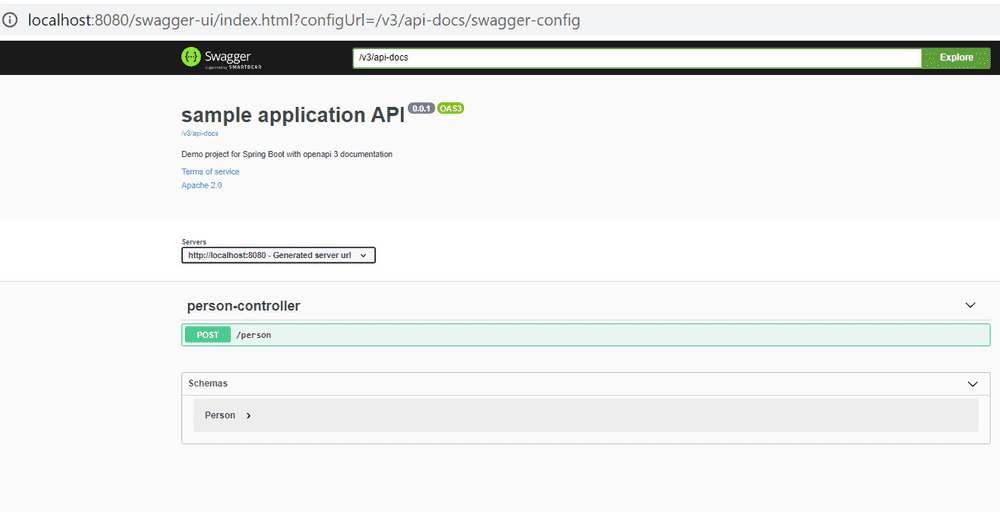OpenAPI 3 Documentation With Spring Boot
In this tutorial, we are going to try out a Spring Boot Open API 3-enabled REST project and explore some of its capabilities. Springdoc-openapi java library is fast becoming very compelling.
We are going to refer to https://spring.io/guides/gs/rest-service/ and https://springdoc.org/.
Prerequisites:
- Java 8.x.
- Maven 3.x.
Steps
Start by creating a Maven JAR project. Below, you will see the pom.xml to use:
<?xml version="1.0" encoding="UTF-8"?>
<project xmlns="http://maven.apache.org/POM/4.0.0"
xmlns:xsi="http://www.w3.org/2001/XMLSchema-instance"
xsi:schemaLocation="http://maven.apache.org/POM/4.0.0 https://maven.apache.org/xsd/maven-4.0.0.xsd">
<modelVersion>4.0.0</modelVersion>
<parent>
<groupId>org.springframework.boot</groupId>
<artifactId>spring-boot-starter-parent</artifactId>
<version>2.2.2.RELEASE</version>
<relativePath ></relativePath> <!-- lookup parent from repository -->
</parent>
<groupId>com.example</groupId>
<artifactId>sample</artifactId>
<version>0.0.1</version>
<name>sample</name>
<description>Demo project for Spring Boot with
openapi 3 documentation</description>
<properties>
<java.version>1.8</java.version>
</properties>
<dependencies>
<dependency>
<groupId>org.springframework.boot</groupId>
<artifactId>spring-boot-starter-web</artifactId>
</dependency>
<dependency>
<groupId>org.springdoc</groupId>
<artifactId>springdoc-openapi-ui</artifactId>
<version>1.2.32</version>
</dependency>
<dependency>
<groupId>org.springframework.boot</groupId>
<artifactId>spring-boot-starter-test</artifactId>
<scope>test</scope>
<exclusions>
<exclusion>
<groupId>org.junit.vintage</groupId>
<artifactId>junit-vintage-engine</artifactId>
</exclusion>
</exclusions>
</dependency>
</dependencies>
<build>
<plugins>
<plugin>
<groupId>org.springframework.boot</groupId>
<artifactId>spring-boot-maven-plugin</artifactId>
</plugin>
</plugins>
</build>
</project>Note the “springdoc-openapi-ui” dependency and “springdoc-openapi-maven-plugin” plugin.
Now, let’s create a small Java bean class.
package sample;
import javax.validation.constraints.Email;
import javax.validation.constraints.Max;
import javax.validation.constraints.Min;
import javax.validation.constraints.NotBlank;
import javax.validation.constraints.NotNull;
import javax.validation.constraints.Pattern;
import javax.validation.constraints.Size;
import javax.xml.bind.annotation.XmlAccessType;
import javax.xml.bind.annotation.XmlAccessorType;
import javax.xml.bind.annotation.XmlRootElement;
import org.hibernate.validator.constraints.CreditCardNumber;
@XmlRootElement(name = "person")
@XmlAccessorType(XmlAccessType.FIELD)
public class Person {
private long id;
private String firstName;
@NotNull
@NotBlank
private String lastName;
@Pattern(regexp = ".+@.+\\..+", message = "Please provide a valid email address")
private String email;
@Email()
private String email1;
@Min(18)
@Max(30)
private int age;
@CreditCardNumber
private String creditCardNumber;
public String getCreditCardNumber() {
return creditCardNumber;
}
public void setCreditCardNumber(String creditCardNumber) {
this.creditCardNumber = creditCardNumber;
}
public long getId() {
return id;
}
public void setId(long id) {
this.id = id;
}
public String getEmail1() {
return email1;
}
public void setEmail1(String email1) {
this.email1 = email1;
}
@Size(min = 2)
public String getFirstName() {
return firstName;
}
public void setFirstName(String firstName) {
this.firstName = firstName;
}
public String getLastName() {
return lastName;
}
public void setLastName(String lastName) {
this.lastName = lastName;
}
public String getEmail() {
return email;
}
public void setEmail(String email) {
this.email = email;
}
public int getAge() {
return age;
}
public void setAge(int age) {
this.age = age;
}
}This is an example of a Java bean. Now, let’s create a controller.
package sample;
import javax.validation.Valid;
import org.springframework.web.bind.annotation.RequestBody;
import org.springframework.web.bind.annotation.RequestMapping;
import org.springframework.web.bind.annotation.RequestMethod;
import org.springframework.web.bind.annotation.RestController;
@RestController
public class PersonController {
@RequestMapping(path = "/person", method = RequestMethod.POST)
public Person person(@Valid @RequestBody Person person) {
return person;
}
}Above is a sample REST Controller.
Let’s make some entries in src\main\resources\application.properties.
application-description=@project.description@
application-version=@project.version@
logging.level.org.springframework.boot.autoconfigure=ERRORThe above entries will pass on Maven build-related information to the OpenAPI documentation.
Finally, let’s write the spring boot application class
package sample;
import org.springframework.beans.factory.annotation.Value;
import org.springframework.boot.SpringApplication;
import org.springframework.boot.autoconfigure.SpringBootApplication;
import org.springframework.context.annotation.Bean;
import org.springframework.context.annotation.ComponentScan;
import io.swagger.v3.oas.models.OpenAPI;
import io.swagger.v3.oas.models.info.Info;
import io.swagger.v3.oas.models.info.License;
@SpringBootApplication
public class SampleApplication {
public static void main(String[] args) {
SpringApplication.run(SampleApplication.class, args);
}
@Bean
public OpenAPI customOpenAPI(@Value("${application-description}") String appDesciption, @Value("${application-version}") String appVersion) {
return new OpenAPI()
.info(new Info()
.title("sample application API")
.version(appVersion)
.description(appDesciption)
.termsOfService("http://swagger.io/terms/")
.license(new License().name("Apache 2.0").url("http://springdoc.org")));
}
}Also note how the API version and description is being leveraged from application.properties.
At this stage, this is what the project looks like in Eclipse:
Above are the project contents. Next, execute the mvn clean package from the command prompt or terminal. Then, execute java -jar target\sample-0.0.1.jar.
You can also launch the application by running the SampleApplication.java class from your IDE.
Now, let’s visit the Swagger UI — http://localhost:8080/swagger-ui.html:
Click the green Post button and expand the > symbol on the right of Person under Schemas.
The nice thing is how the contract is automatically detailed leveraging JSR-303 annotations on the model. It out-of-the-box covers many of the important annotations and documents them. However, I did not see it support out of the box @javax.validation.constraints.Email and @org.hibernate.validator.constraints.CreditCardNumber at this point in time.
For completeness, let’s post a request. Press the Try it out button.
Press the blue execute button.
Let’s feed in a valid input:
JSON
{
"id": 0,
"firstName": "string",
"lastName": "string",
"email": "[email protected]",
"email1": "[email protected]",
"age": 20,
"creditCardNumber": "4111111111111111"
}Let’s feed that valid input into the Request Body Section
On pressing the blue Execute button we see the below:
This was only a brief introduction to the capabilities of the dependency:
XML
<dependency>
<groupId>org.springdoc</groupId>
<artifactId>springdoc-openapi-ui</artifactId>
<version>1.2.32</version>
</dependency>Troubleshooting Tips
- Ensure prerequisites.
- If using the Eclipse IDE, we might need to do a Maven update on the project after creating all the files.
- In the Swagger UI, if you are unable to access the “Schema” definitions link, it might be because you need to come out of the “try it out “ mode. Click on one or two Cancel buttons that might be visible.






